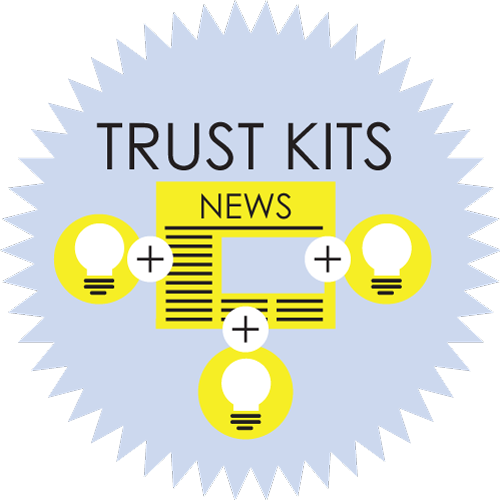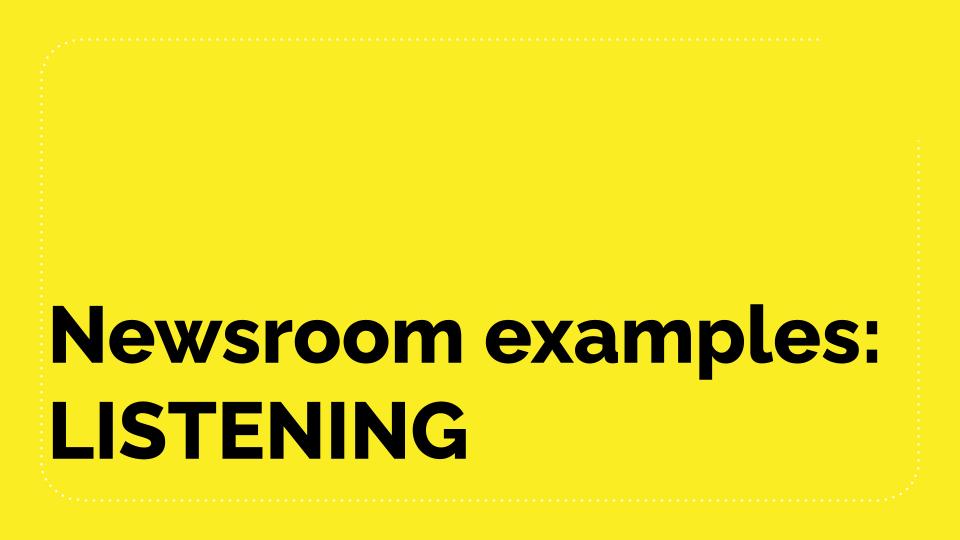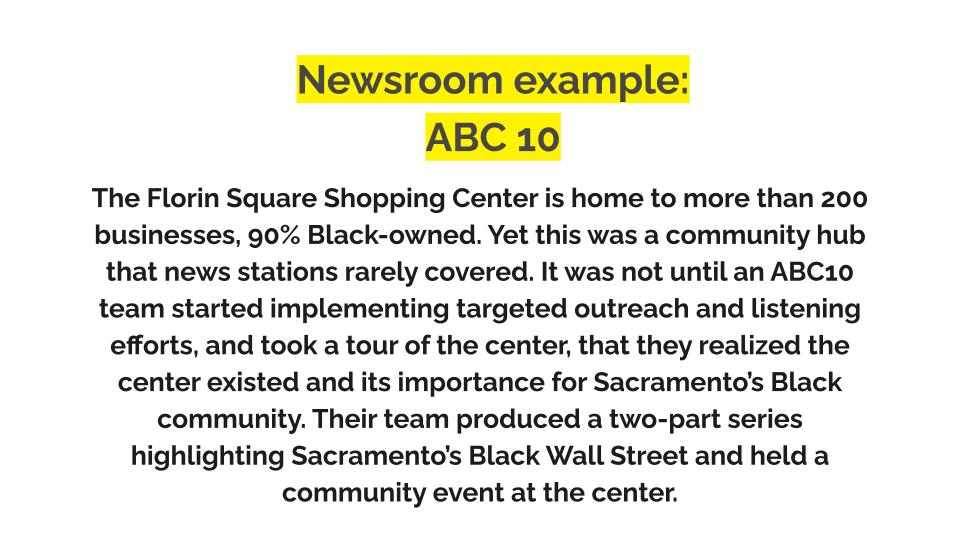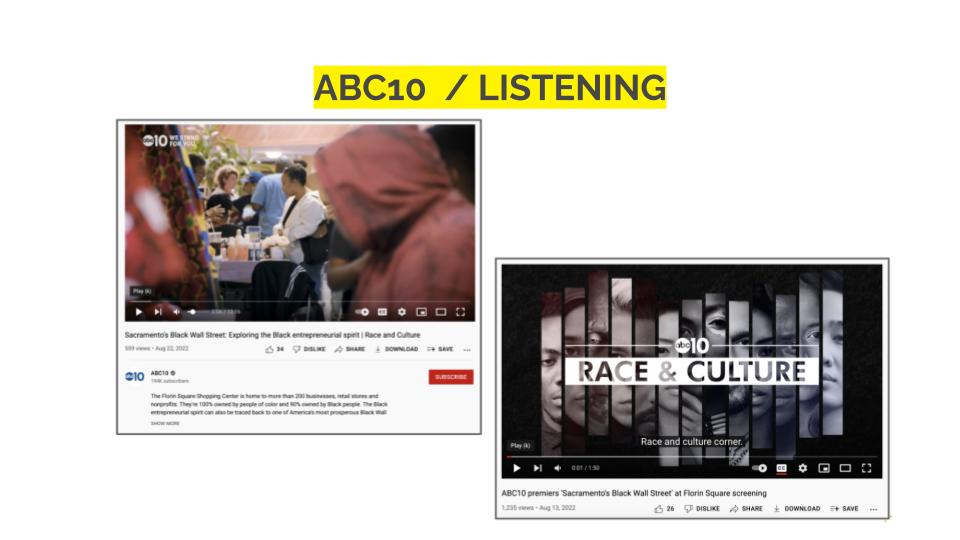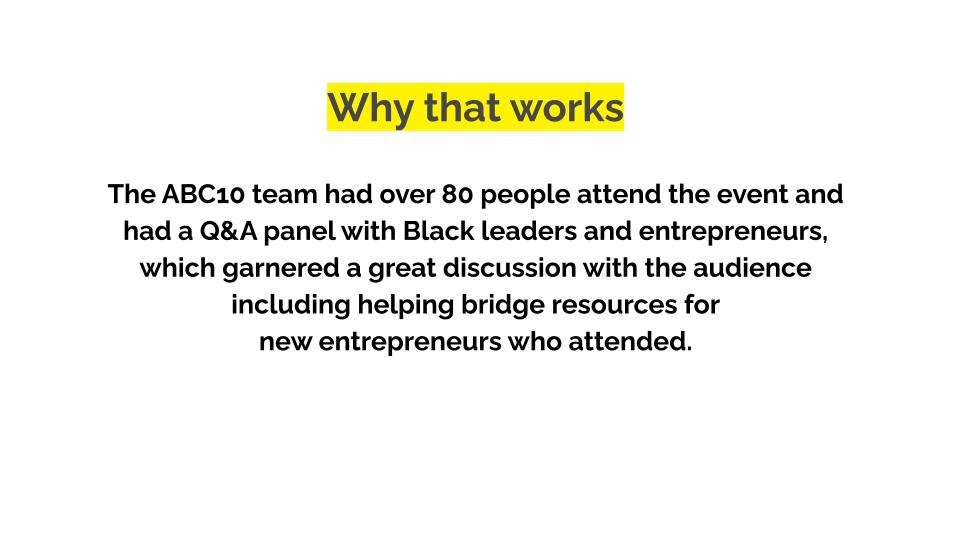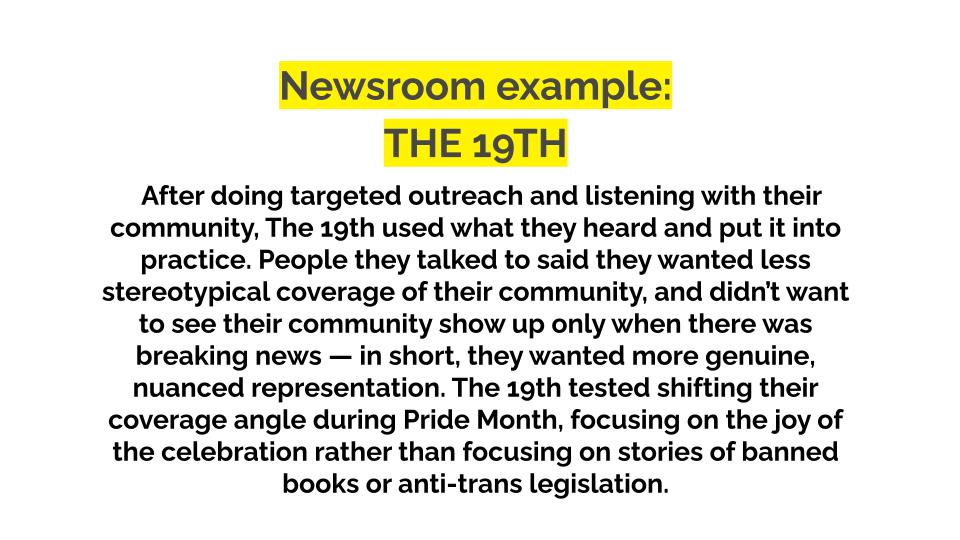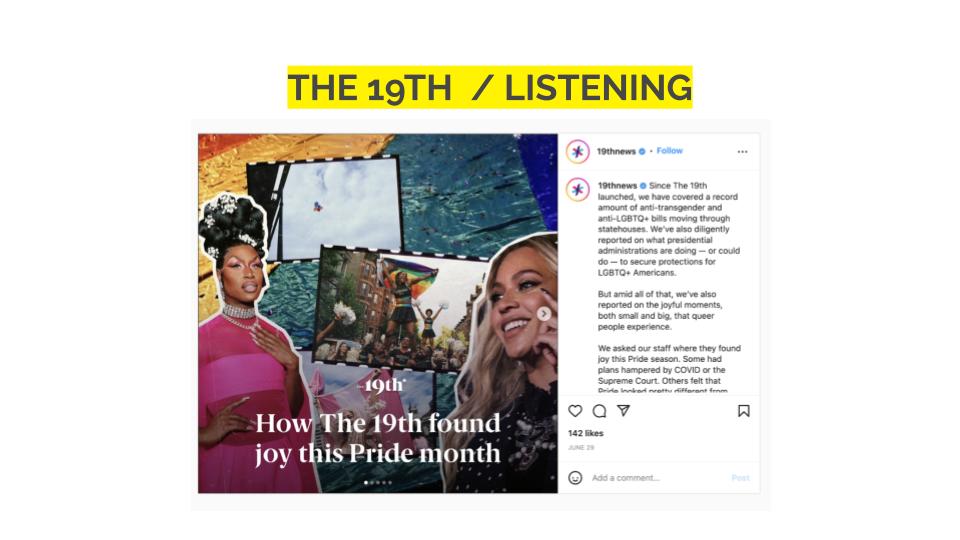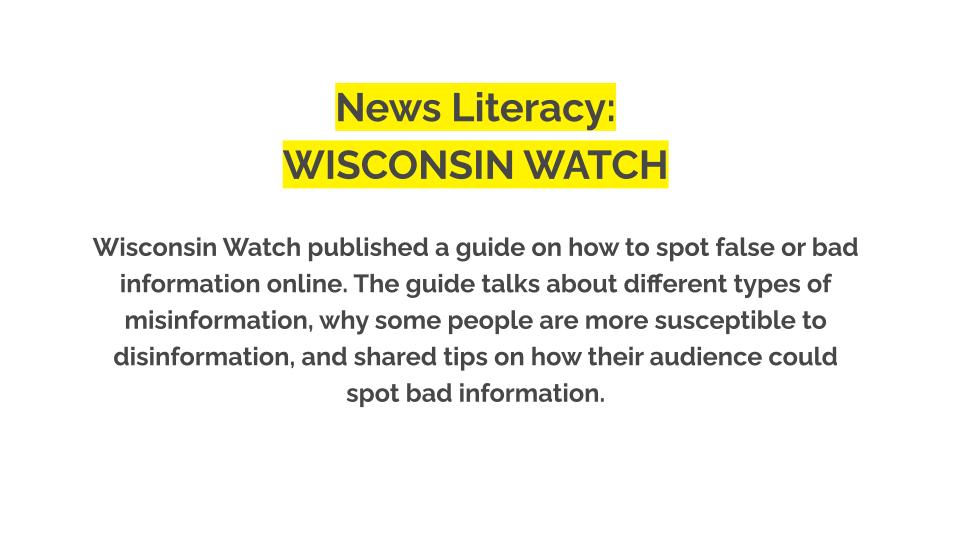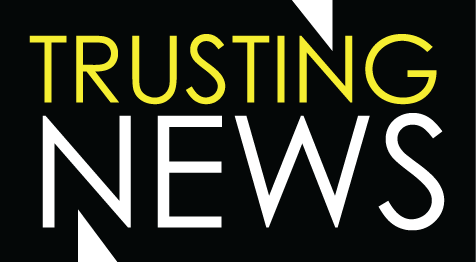ENGAGEMENT
Listening to reach new, diverse audiences
It’s great that many journalists are working to provide better coverage of communities that have been historically ignored or underrepresented by news media. But something we see journalists skip in pursuit of building and reaching new audiences is listening and getting curious about people’s experiences with and perspectives of the news.
Without understanding the assumptions that have led to distrust and the roadblocks that exist in creating sustained relationships, it’s almost impossible for journalists to effectively serve these audiences.
The good news is we know, thanks to research, that simply listening to community members who don’t trust you helps build trust.
This Trust Kit will walk you through how to reach new audience by incorporating the practice of listening into larger newsroom efforts could have.
How can journalists effectively serve audiences without first knowing who it is they are serving and how well they’re doing it?

Goals
This Trust Kit helps you:
- Identify audiences you might not be already reaching
- Find those people and talk to them
- Have conversations driven by curiosity, not defensiveness
- Develop strategies for reaching specific groups of people
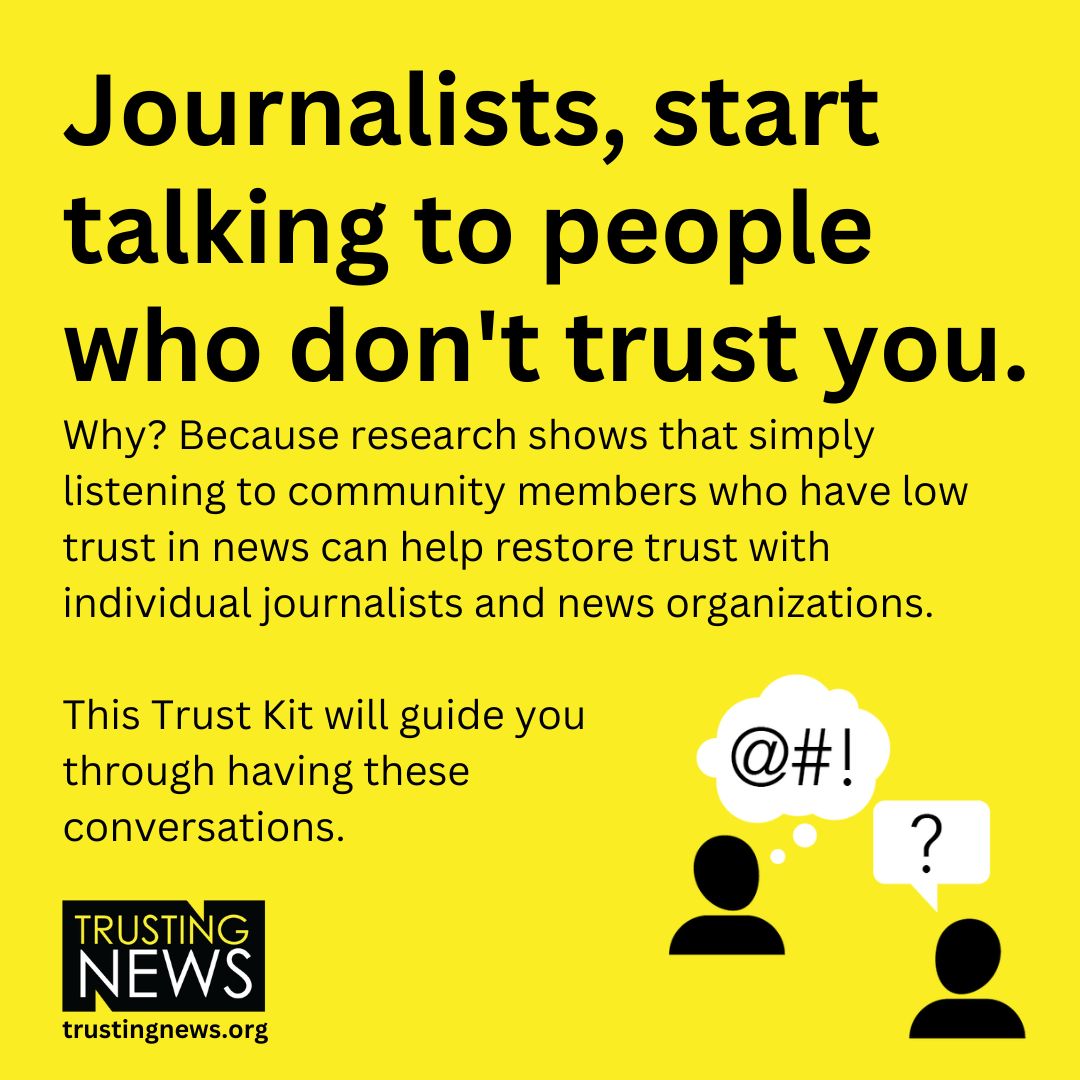

Start here
Here are steps to take as you work to hear from people you haven’t traditionally heard from. Click or tap the blue boxes to expand each section.
Step 1: Identify who you want to hear from
The goal of having these conversations is to hear from people who do not already have a strong relationship with your news organization or hear from groups that typically hold low trust for mainstream news organizations, such as conservative voters, immigrants and communities of color.
If you’re not already in tune with what communities don’t trust your news, start by taking stock of what voices tend to be missing in your coverage. You can also examine the feedback you hear from users and take a closer look at your current audience, and think about who isn’t there.
Step 2: Find people to talk to
Once you’ve identified who you want to hear from, think about how you can reach those people.
Some ideas: Look through your comment sections for people complaining about your work; reach out on social media (think, Facebook Groups, Nextdoor); ask existing sources to help connect you with someone in their circles; spend time at community spaces or at local events; ask community leaders and organizations for recommendations.
We know community members feel journalists rely too heavily on over-generalizations and simplification of problems, so avoid trying to find the loudest or most polarizing people.
Of course, one person can’t represent an entire community. Remember you are here to learn about this person’s experiences, not to ask them to serve as a spokesperson for an entire group or community.
Step 3: Root the conversation in curiosity
Set up the conversation by explaining who you are and what you’re doing. If this is tied into a larger newsroom project or effort, mention that.
Remember: Your goal is to learn about your community member’s perceptions and experiences — what they feel journalists get right and wrong, and how journalists can better reflect and be relevant to the people they aim to serve. It’s not to defend your work — or the entirety of the news industry.
Step 4: Ask questions like these
We have a community interview guide that walks journalists through how to have conversations with people who have low trust in news.
The guide las a list of suggested questions to ask when having conversations with people who have low trust in news.
Go through and ask the questions that feel relevant, skipping or rearranging the list in whatever way feels natural in the conversation.
Step 5: Build it into someone's job
Assign a journalist to keep an eye on responses you’re hearing from the community and look for patterns to report back. You could use a Google form for easy tagging and sorting of answers.
After you conduct enough interviews to see some themes, have that journalist share a summary of what information they gather with the team. To easily share insights, they could share one key thing they heard in a dedicated Slack channel or other newsroom-wide communication systems. You could also ask one person to elaborate on their encounter in each staff meeting.
And to close your feedback loop. be sure to send a note afterward thanking any community members for their time. If you can, share an observation about what you learned, what you’ll share with your colleagues or what you will keep in mind in your own work as a result of the conversation.

General conversation tips
- Remember this is not a debate. Your goal is to listen and learn. If the interviewee says things about journalism, or about your work specifically, that you’d like to correct or defend, try to save those points for the end. The primary goal of the conversation is to listen and understand, not bring them to your side, and not to win an argument
- When possible, keep the conversation focused on your work and on local journalism in your community. When participants talk about “the media,” invite them to get more specific. Also, invite specificity when terms like “objectivity,” “bias,” and “agenda” come up. Ask them what they mean by those terms.
- Explain what you’re doing ahead of time. Once you sit down with the person (we recommended these be done in person or over Zoom so you can see body language and facial expressions) explain what you are doing and why. Help set the expectation of what kind of questions you’re going to ask, to help them feel at ease. Also explain how you plan to use what they share, if at all. We recommend not sharing anything publicly without their permission. You’re not there to do a story. You’re there to learn.
- We also encourage you, when appropriate, to acknowledge any place of privilege and positions of power you hold, even as the journalist hosting the conversation. Acknowledge that your news organization may have lost trust over the years, but you’re striving to do better and want to understand issues facing your community.

Reaching specific audiences
So often the groups newsrooms are trying to better serve — conservative voters, immigrants and communities of color — are groups that typically have low trust in news.
Alongside partner newsrooms, we’ve conducted research and found some best practices. Spoiler: They all involve the kind of deep, consistent listening we’ve been talking about in this kit. Click or tap the blue boxes to expand each section.
Earning trust with BIPOC communities
When it comes to communities of color, the challenge is often not about rebuilding trust, but about building a relationship from scratch.
When community members feel the news has not been made by or for people like them, there isn’t a connection or loyalty to build on. Worse, some communities have been legitimately harmed by news coverage that has misrepresented or exploited them.
Here is what our partner newsrooms and journalists have heard from people of color:
- Journalists parachute in when something goes wrong
- News only covers their community in a negative light, or when there’s a problem
- Journalists flatten or generalize people’s identities and experiences
- People notice the diversity (or lack thereof) of journalists and in newsrooms
For journalists who care deeply about providing a public service and accurately reaching their communities, this should be deeply troubling. Most newsrooms want to invest in doing better, but figuring out what the specific goals should be and how to measure improvement can be complicated.
We recommend you start with deep listening. Start by reaching out to people you’ve talked to before. Have one-on-one conversations. One-on-one conversations allow for more connection and nuance, but you can also try to ask these questions or reach people through outline callouts or at events.
Then commit to changing by measuring your success. Measuring success and progress in these areas can be challenging. Letrell Deshan Crittenden at American Press Institute developed a rubric to help assess diversity and inclusion of newsroom staff, processes and coverage. Filling out this rubric as a newsroom can be a good starting point to hold yourself accountable.
Finally, tell your community what you’re up to. Share your efforts – and perhaps also your self-assessment — with your community. Transparency breeds trust. Your goals and integrity are invisible unless you shine a light on them. People won’t give you automatic credit for your efforts, especially when they have a long history of reasons not to.
Additional resources and newsroom examples:
- KQED CAP community advisory panel meets with the KQED board and holds the organization accountable
- Take an activity to other orgs’ events. WFAE created a wheel for people to spin to learn more about their reporting. They bring this to community events.
- Nashville’s Black Voices newsletter and Facebook group
- Oakland Voices citizen journalist training from the community-level up
- El Tímpano’s texting circle + deep listening
- La Estrella’s commitment to translation and engagement in Tuscon
- Chatham News + Record commitment to bilingual coverage and outreach
- Florida Times-Union’s Instagram strategy targets a young, diverse audience
- Latino listening project in Idaho focuses on education coverage
Earning trust with politically conservative audiences
Research shows people who identify as politically conservative have lower trust in news than the average American.
In 2021, we worked with partner newsrooms and Center for Media Engagement to better understand the societal and psychological forces that influence polarization and perceptions of news.
You can read the full research here. Once again, the building block of what we heard is news organizations and journalists need to do a better job building relationships and listening to the perspectives of people who have politically conservative and right-leaning viewpoints. To do this, we recommend you use our community interview guide.
Here are is what else we learned about how newsrooms can better connect with conservative and right-leaning audiences. (Read this if you want to dive deeper into each of these tips and strategies.)
- Include a variety of voices from people with politically conservative and right-leaning views in stories.
- Be cautious of using “conservative” or other terms as catch-all labels for people who may have very different beliefs.
- Consider the diversity of political beliefs and backgrounds when hiring.
- Focus on story facts, not interpretation.
- Correct mistakes promptly to demonstrate trustworthiness.
- Don’t criticize only one side of an issue.
If you’re looking for more guidance and ideas, check out this webinar we hosted on the impact journalists saw when they spent the time to do one-on-one outreach with people with low trust in news in their communities.
We know this takes time.
We fully recognize that it can be hard to make time for engagement efforts. But we think the time investment is worth the payoff.
We’ve tested these listening strategies with partner journalists and on average, it took them less than an hour to set up and conduct a conversation like the ones we recommend above. Meaning if you did one of these a week, that would only be around 1/40th of your work week.
At the end of a year, you would have connected with dozens of new people. And our bet is that having those conversations in mind while you decide what to cover, what questions to ask and what to explain about your work would make the work richer and more relevant to the people you aim to serve.
See how other newsrooms do it
For inspiration, here are some examples of how other newsrooms used feedback they heard from listening and community conversations to help shape their coverage. For more newsroom examples, check our our newsroom example database.
We’re here to help!
Congratulations on getting this far in the Trust Kit! 🎉 We know taking the steps to earn trust isn’t always simple or easy. It takes time and often requires a shift in newsroom routines or workflows.
Any progress you make on implementing strategies in this Trust Kit should be celebrated as a win!
If you find yourself getting stuck, need help brainstorming, or have completed the work in a Trust Kit and would like our team to review and give additional advice, reach out to us at info@trustingnews.org or send us a message on Twitter.
This Trust Kit was last updated May 12, 2023.
